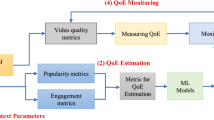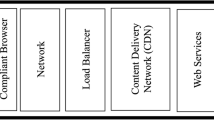Abstract
Improving quality of experience (QoE) is increasingly significant for Internet video content providers. The essential issue is how to evaluate QoE under the complex circumstance of Internet video. Based on the massive user data extracted from a large scale Video-on-Demand (VoD) provider, we present a data-driven, comprehensive and extendible study on the problems of QoE evaluation. The main works of this paper include obtaining QoE-associated features via feature engineering and building an evaluation model on features of different aspects for Internet video QoE. Firstly, for feature engineering, we propose to introduce pattern features of user viewing behaviors that interact with user-perceived video quality. A new method of frequent time series pattern mining is proposed to find typical patterns. We correlate user experience with user-perceived quality features and user behavior pattern features, and consider the impact of confounding factors by applying them as context features into modeling. Secondly, interdependency among features is challenging for QoE evaluation modeling. And the high dimension of feature vector should be considered. To address these challenges, we develop an ensemble method to model the interactions between features and their intricate relationships to user experience. Experiments demonstrate that our approach could achieve sound results in comparison with other related works.


















Similar content being viewed by others
Notes
The support level is the frequency of a pattern that occurs in our dataset.
Because of the confidential agreement, we should not mention the name of the content provider.
We conduct K-means algorithm getting rid of values that is too large according to the distribution, since K-means is sensitive to singular value.
In this section, we temporarily set the threshold of DVC to 0.7, labeling video session instance to good or bad DVC. We make a further analysis of DVC threshold in Section 5.4
References
Agrawal R, Srikant R (1995) Mining sequential patterns. In: Proceedings of the Eleventh international conference on data engineering, 1995. IEEE, pp 3–14
Agrawal R, Mannila H, Srikant R, Toivonen H, Verkamo AI (1996) Fast discovery of association rules. In: Advances in knowledge discovery and data mining, pp 307–328
Agarwal RC, Aggarwal CC, Prasad VVV (2002) Depth first generation of long patterns. In: ACM SIGKDD International conference on knowledge discovery and data mining, pp 108–118
Agboma F, Liotta A (2012) Quality of experience management in mobile content delivery systems. Telecommun Syst 49(1):85–98
Ayres J (2002) Sequential pattern mining using a bitmap representation. In: Eighth ACM SIGKDD International conference on knowledge discovery and data mining, pp 429–435
Balachandran A, Sekar V, Akella A, Seshan S (2013) Analyzing the potential benefits of CDN augmentation strategies for internet video workloads. In: Conference on internet measurement conference, pp 43–56
Balachandran A, Sekar V, Akella A, Seshan S (2013) Understanding internet video viewing behavior in the wild. In: ACM SIGMETRICS/International conference on measurement and modeling of computer systems, pp 379–380
Balachandran A, Sekar V, Akella A, Seshan S, Stoica I, Zhang H (2013) Developing a predictive model of quality of experience for internet video. Comput Commun Rev 43(4):339–350
Bayardo RJ (1998) Efficiently mining long patterns from databases. ACM SIGMOD Record 27(2):85–93
Breiman L (1996) Bagging predictors. Mach Learn 24(2):123–140
Bryll R, Gutierrez-Osuna R, Quek F (2003) Attribute bagging: improving accuracy of classifier ensembles by using random feature subsets. Pattern Recogn 36 (6):1291–1302
Casas P, Schatz R, Hoßfeld T (2013) Monitoring YouTube QoE: is your mobile network delivering the right experience to your customers? In: IEEE Wireless communications and networking conference, pp 1609–1614
Chen L, Zhou Y, Chiu DM (2014) A study of user behavior in online VoD services. Comput Commun 46(6):66–75
Cheng H, Yan X, Han J, Hsu CW (2007) Discriminative frequent pattern analysis for effective classification. In: IEEE International conference on data engineering, pp 716–725
Choi J, Reaz A, Mukherjee B (2012) A survey of user behavior in VoD service and bandwidth-saving multicast streaming schemes. Commun Surv Tutor IEEE 14(1):156–169
Diewert E (2005) Weighted country product dummy variable regressions and index number formulae. Rev Income Wealth 51(4):561–570
Dobrian F, Awan A, Joseph DA, Ganjam A, Zhan J, Sekar V, Stoica I, Zhang H (2013) Understanding the impact of video quality on user engagement. Commun ACM, 56(3):91–99
Domingos P (2012) A few useful things to know about machine learning. Commun ACM 55(10):78–87
Freudenthaler C, Schmidt-Thieme L, Rendle S (2013) Bayesian factorization machines
Gopalakrishnan V, Jana R, Ramakrishnan KK, Swayne DF, Vaishampayan VA (2011) Understanding couch potatoes: measurement and modeling of interactive usage of IPTV at large scale. In: Proceedings of the 2011 ACM SIGCOMM conference on Internet measurement conference, pp 225–242
Greenacre MJ (2007) Correspondence analysis in practice, 2nd edn. Crc Press
Guyon I, Elisseeff A (2003) An introduction to variable and feature selection. J Mach Learn Res 3(6):1157–1182
Han J, Pei J, Yin Y (2000) Mining frequent patterns without candidate generation. ACM Sigmod Record 29(2):1–12
Jana S, Chan A, Pande A, Mohapatra P (2016) QoE prediction model for mobile video telephony. Multimed Tools Appl 75(13):7957–7980
Joumblatt D, Chandrashekar J, Kveton B, Taft N (2013) Predicting user dissatisfaction with Internet application performance at end-hosts. In: INFOCOM, 2013 Proceedings IEEE, pp 235–239
Klir GJ, Yuan B (1994) Fuzzy sets and fuzzy logic: theory and applications. Prentice-Hall, Inc
Krishnan SS, Sitaraman RK (2013) Understanding the effectiveness of video ads: a measurement study. In: Conference on internet measurement conference, pp 149–162
Krishnan SS, Sitaraman RK (2013) Video stream quality impacts viewer behavior: inferring causality using quasi-experimental designs. IEEE/ACM Trans Network 21(6):2001–2014
Li Z, Lin J, Akodjenou MI, Xie G, Kaafar MA, Jin Y, Peng G (2012) Watching videos from everywhere: a study of the PPTV mobile VoD system. In: ACM Conference on internet measurement conference, pp 185–198
Mok RKP, Chan EWW, Chang RKC (2011) Measuring the quality of experience of HTTP video streaming. In: IFIP/IEEE International symposium on integrated network management, pp 485–492
Mok RKP, Chan EWW, Luo X, Chang RKC (2011) Inferring the QoE of HTTP video streaming from user-viewing activities. In: ACM SIGCOMM Workshop on measurements up the stack, pp 31–36
Mongy S, Djeraba C, Dan AS (2007) On clustering users’ behaviors in video sessions. In: International conference on data mining, Dmin 2007. Las Vegas, pp 99–103
Ng A (2016) Machine learning coursera
Reiter U, Brunnström K, Moor KD, Larabi M, Pereira M, Pinheiro A, You J, Zgank A (2014) Factors influencing quality of experience, pp 55–72
Rendle S (2012) Factorization machines with libFM. ACM Trans Intell Syst Technol 3(3):57
Rish I (2001) An empirical study of the naive bayes classifier. J Univ Comput Sci 1(2):127
Robitza W, Raake A (2016) (Re-)actions speak louder than words? A novel test method for tracking user behavior in web video services. In: Eighth International conference on quality of multimedia experience, pp 1–6
Shenoy P, Haritsa JR, Sudarshan S, Bhalotia G, Bawa M, Shah D (2000) Turbo-charging vertical mining of large databases. ACM Sigmod Record 29(2):22–33
Shewhart WA, Wilks SS (2005) Applied logistic regression, 2nd edn
Søgaard J, Shahid M, Pokhrel J, Brunnstrȯm K (2017) On subjective quality assessment of adaptive video streaming via crowdsourcing and laboratory based experiments. Multimed Tools Appl 76(15):16,727–16,748
Song HH, Ge Z, Mahimkar A, Wang J, Yates J, Zhang Y, Basso A, Chen M (2011) Q-score: proactive service quality assessment in a large IPTV system. In: ACM SIGCOMM Conference on internet measurement conference, pp 195–208
Trouleau W, Ashkan A, Ding W, Eriksson B (2016) Just one more: modeling binge watching behavior. In: ACM SIGKDD International conference on knowledge discovery and data mining, pp 1215–1224
Xiao Z, Xu Y, Feng H, Yang T, Hu B, Zhou Y (2015) Modeling streaming QoE in wireless networks with large-scale measurement of user behavior. In: 2015 IEEE Global communications conference (GLOBECOM), pp 1–6
Yu H, Zheng D, Zhao BY, Zheng W (2006) Understanding user behavior in large-scale video-on-demand systems. In: Eurosys conference, pp 333–344
Yue T, Wei AM, Wang HB, Deng XD, Cheng SD (2016) A comprehensive data-driven approach to evaluating quality of experience on large-scale Internet video service. In: 2016 12th International Conference on natural computation, fuzzy systems and knowledge discovery (ICNC-FSKD). IEEE, pp 1479–1486
Zaki MJ, Hsiao CJ (2002) Charm: an efficient algorithm for closed itemset mining. In: Siam International conference on data mining. Arlington, pp 457–473
Zaki MJ, Parthasarathy S, Ogihara M, Li W et al (1997) New algorithms for fast discovery of association rules. In: KDD, vol 97, pp 283–286
Zhang D, Zhou D, Jin X (2017) A content-adaptive video quality assessment method for online media service. Multimed Tools Appl 76(5):7175–7195
Author information
Authors and Affiliations
Corresponding author
Rights and permissions
About this article
Cite this article
Yue, T., Wang, H. & Cheng, S. Learning from users: a data-driven method of QoE evaluation for Internet video. Multimed Tools Appl 77, 27269–27300 (2018). https://doi.org/10.1007/s11042-018-5918-4
Received:
Revised:
Accepted:
Published:
Issue Date:
DOI: https://doi.org/10.1007/s11042-018-5918-4




